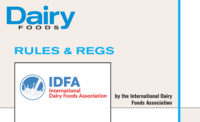The calorie countdown begins in restaurants, vending machines

Prompted by the Affordable Care Act of 2010, calorie counts will soon be posted on chain restaurant menus and foods sold in vending machines. While these changes don’t directly impact dairy products, processors that sell products to foodservice or vending customers should be aware of and be prepared for the new requirements.
The National Restaurant Association advocated for establishing uniform requirements in the health care bill instead of having a patchwork of different state and local government laws that affect more than 200,000 restaurant locations nationwide. To help consumers make informed decisions about meals and snacks, the U.S. Food and Drug Administration recently finalized two rules with the details of how calorie information will be listed on menus and menu boards in chain restaurants (and similar retail food establishments) and vending machines
The menu labeling final rule applies to restaurants and entertainment venues, such as movie theaters, if they are part of a chain of 20 or more locations, doing business under the same name and offering the same menu items. The rules also will apply to buffets, salad bars, self-service items and beverages, including some alcoholic drinks, but will not include daily specials and seasonal items. Similar retail food establishments, including grocery and convenience stores, will need to comply with menu-labeling requirements if they sell products similar to restaurants, such as prepared sandwiches or slices of pizza. Foods purchased in grocery stores or other retail food establishments that are typically intended for more than one person to eat and require additional preparation before consuming (such as pounds of deli meats and cheeses) are not covered.
With me so far?
Labeling dairy products
With restaurants offering a multitude of food selections to meet everyone’s individual taste, it would be impossible to give calorie information for every menu option. Here’s how FDA dictated the details for labeling dairy products. According to the final rules, restaurants would need to label foods that are offered in a variety of sizes or flavors, such as an ice cream cone or a pizza with different combinations of toppings. When a food item is on the menu with more than two options, a calorie range will be presented going from the lowest calorie variety option to the highest calorie option (for example, “100-250”). For pizza, the rules will allow labeling the calories either for the whole pizza as usually prepared (“pizza pie: 1,600 calories) or per slice as long as the total number of servings per pizza is declared (“pizza pie: 200 cal./slice, 8 slices).
Restaurants and similar retail food establishments that are covered will have until Dec.1 to add calorie counts to their menus or menu boards.
The vending machine final rule requires operators who own or operate 20 or more vending machines to disclose calorie information for food and beverages, although there are certain exceptions. The final vending rule allows for several different ways to display calories for vending machines, including an exemption if the calories, serving size and serving per container information are visible on the vending machine food, either through a front-of-pack symbol (FOP) or the entire Nutrition Facts panel.
In the final rule, FDA clarified that an FOP declaration would be considered a nutrient content claim and full nutrition labeling would then be required on the food package itself. Front-of-pack labels would eliminate the need for vending machine operators to post a separate sign; therefore, dairy companies that sell products in vending machines such as milk, yogurt or string cheese may get requests from operators to add a FOP calorie statement.
Vending operators that are covered will have until Dec.1, 2016 to comply with the requirements.
It’s the restaurant’s duty
Generally, the responsibility for correct calorie declaration will rest with the restaurants or vending machine operator. But since nearly all products in restaurants will need to declare calorie counts, dairy companies should be ready to provide nutrition information to their foodservice customers.
Restaurants and vending machine operators may decide to alter their products to offer lower calorie choices for consumers. When FDA changed retail labeling requirements to add trans-fat declarations, many food manufacturers changed their formulations to reduce their trans-fat content. Restaurants may do something similar. This may provide new opportunities for dairy manufacturers to sell dairy products and foodservice dairy ingredients that are formulated to contain fewer calories.
Many of your foodservice and vending machine customers will be scrambling to calculate the nutrient content and post compliant labeling. Dairy processors can help streamline this process by readily supplying nutrition information and being prepared for possible requests for label or formulation changes.
The International Dairy Foods Association can provide support to its members in the area of labeling, standards and nutrition policy to help the dairy industry understand the details and compliance for counting calories in restaurants and vending, as well as for other regulations.
Looking for a reprint of this article?
From high-res PDFs to custom plaques, order your copy today!







